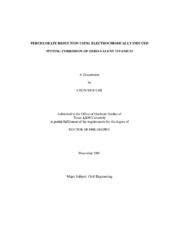| dc.contributor.advisor | Batchelor, Bill | |
| dc.creator | Lee, Chun Woo | |
| dc.date.accessioned | 2010-01-15T00:12:30Z | |
| dc.date.accessioned | 2010-01-16T00:35:32Z | |
| dc.date.available | 2010-01-15T00:12:30Z | |
| dc.date.available | 2010-01-16T00:35:32Z | |
| dc.date.created | 2007-12 | |
| dc.date.issued | 2009-05-15 | |
| dc.identifier.uri | https://hdl.handle.net/1969.1/ETD-TAMU-2475 | |
| dc.description.abstract | Perchlorate is a threat to public health through water but also food. However,
there is no effective chemical treatment process which can destroy perchlorate found in
groundwater and surface water. Thus, there is growing interest in developing effective
technologies, especially chemical treatments, to completely destroy trace levels of
perchlorate present in drinking and groundwater.
The research on perchlorate reduction by zero-valent titanium (Ti(0)) showed
that perchlorate was effectively reduced to chloride using electrochemically developed
pitting corrosion on Ti(0). Perchlorate reduction was believed to be caused by an active
reductant (dissolved Ti(II)) during the pitting corrosion of Ti(0). The rate of perchlorate
reduction was independent on the imposed potential as long as the potential was
maintained above the pitting potential of Ti(0), but it was proportional to the applied
current. The perchlorate reduction on the pitting developed Ti(0) was inhibited by the
presence of chloride and bromide. Inhibition mechanism of perchlorate reduction inhibition was believed to be caused either by competitive adsorption of aggressive
anions on bare Ti(0) surface or Ti(II) consumption by electrochemically produced
chlorine. Kinetic models were developed based surface coverage of aggressive anions on
bare Ti(0) and Ti(II) oxidation by chlorine. These kinetic models supported the
perchlorate concentration change in the solution, but Ti(II) consumption model was not
able to predict chloride concentration due to insufficient information describing complex
nature of pitting on Ti(0).
These results shown in this research demonstrate that pitting corrosion developed
Ti(0) has the capability to chemically reduce perchlorate present in natural water and
engineered systems as well as possible problems associated with electric input. This
research may be a starting point for development of a new treatment process that applies
titanium or titanium metal ions as a chemical reductant to abate contaminants present in
natural and engineering systems. Further developments can be achieved by alloying
titanium metal with other metals such as iron and aluminum, and finding a methodology
producing stable Ti(II) in ambient conditions. | en |
| dc.format.medium | electronic | en |
| dc.format.mimetype | application/pdf | |
| dc.language.iso | en_US | |
| dc.subject | perchlorate | en |
| dc.subject | titanium | en |
| dc.subject | pitting corrosion | en |
| dc.subject | remediation | en |
| dc.title | Perchlorate reduction using electrochemically induced pitting corrosion of zero-valent titanium | en |
| dc.type | Book | en |
| dc.type | Thesis | en |
| thesis.degree.department | Civil Engineering | en |
| thesis.degree.discipline | Civil Engineering | en |
| thesis.degree.grantor | Texas A&M University | en |
| thesis.degree.name | Doctor of Philosophy | en |
| thesis.degree.level | Doctoral | en |
| dc.contributor.committeeMember | Autenrieth, Robin | |
| dc.contributor.committeeMember | Chu, Kung-Hui | |
| dc.contributor.committeeMember | Zhan, Hongbin | |
| dc.type.genre | Electronic Dissertation | en |
| dc.type.material | text | en |
| dc.format.digitalOrigin | born digital | en |


